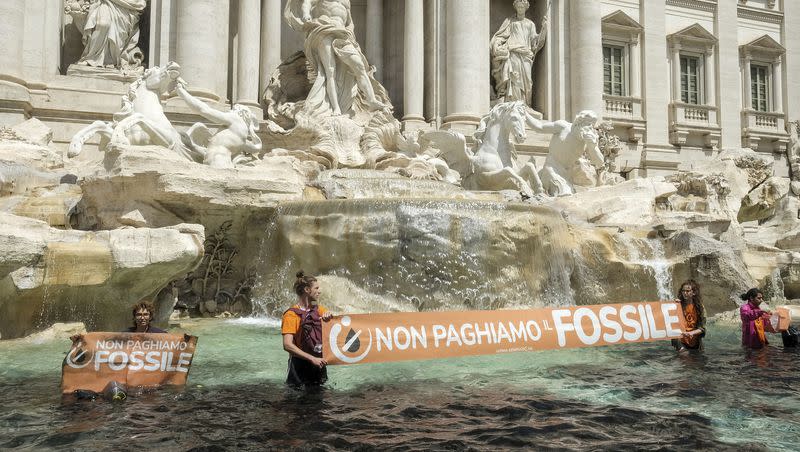Perspective: The war on art is a war on beauty

Climate activists in Italy recently desecrated the world-famous Trevi Fountain in Rome. The protesters, members of the self-proclaimed “Ultima Generazione” (the “Last Generation”) entered the crystalline waters to pollute the fountain with black vegetable charcoal (almost 80,000 gallons) of water and possibly leaving irreparable damage.
Sadly, the incident is not without precedent. Within the past few years, other climate activists from “Just Stop Oil” — a group with which the Italian protesters were affiliated — have thrown tomato soup at paintings and glued their hands to the wall at London’s National Gallery. Others have thrown mashed potatoes at a Monet painting, while another glued his head to Vermeer’s famous painting “Girl with a Pearl Earring.”
#BREAKING: Climate activists have poured black dye into the historic Trevi Fountain, in Rome.
These acts of vandalism can potentially damage the white stone, and have been roundly condemned throughout Italy.
Will there be prosecution by the government?
pic.twitter.com/ijiGcBcHIV— Bree A Dail (@breeadail) May 21, 2023
Whether or not you agree with the climate politics at the root of the vandalism, or even the effectiveness of these tactics, there is an underlying problem that puts these performances in the theater of the absurd.
Let me illustrate with an example. When someone makes the claim “there is no truth,” they undercut themselves from the start by making a claim to truth. To say “there is no truth” is to state a truth. Thus their words negate the claim before they can even defend it.
The same phenomena takes place in each of these incidents of climate activism with regard to beauty. The activists claim that, because of global warming, the Earth is becoming more dangerous, more chaotic, more disorderly and essentially, more ugly. But these acts of protest only add to the disorder and ugliness of our world.
Writing for The Atlantic, Robinson Meyer argued that the activists aren’t making the point that they think they are. At root, climate activists and art curators have the same goals: “They’re both trying to preserve a priceless intergenerational gift for the public.” Moreover, the vandalism is simply a bad look for those who are seeking to do good.
Related
To get at why these acts look so bad, we must understand beauty; and to understand beauty we must first understand entropy.
Entropy is the principle that the natural state of all living and ordered things in the universe is to eventually return to chaos and disorder unless acted upon by an ordering force. For example, our physical bodies, which allow us to experience the beauty, pain and mysteries of human life, will fall to the ravages of time and will return to the dust of the earth. This is inevitable: this is entropy. What holds entropy at bay, however, is beauty and order.
We all have firsthand experience with entropy. It’s much easier to wreck your home than it is to keep it clean. It’s easier to gain weight over the winter than to lose it. It’s easier to lay on your couch than to go to church or take a class. To establish order, to resist entropy, is precisely what makes a house beautiful, a body fit, the mind and soul sound.
We give monetary value to beauty and order by paying to keep our homes and schools and roads and parks clean and (at least, momentarily) free from entropy. We pay money and attention to actors and models who work against atrophy and physical decay to keep their bodies free from the strains of entropy through exercise.
At the higher end of the hierarchy of beauty is a work of art. Its intrinsic beauty is a culmination of the artist’s fight against entropy. That such anti-entropy still stands today (the Trevi Fountain, for example, was made in the 1700s) is precisely what makes art beautiful, and the acts of these protestors rather ridiculous.
Ultimately, we love and crave beauty because it represents the divinity within us. It defies entropy, the easy slip into chaos. The beautiful is anti-entropic, it is strong, immovable, and defies the decay of time.
In a sense, climate change is simply a measure of the entropy of the Earth, whether you believe it to be natural or manmade (or both).To work against that entropy — to take responsibility for our stewardship of the Earth — thus becomes a singular act of beauty that we ought to take seriously. But we cannot protect the Earth against entropy by adding to disorder and to ugliness.
Like all great works of art, the Trevi Fountain stands bright as a monument against entropy. The fountain (as with art museums in general) is a sign that at least one among us once fought against entropy and won, and that the effort was noble and virtuous.
Our task is to maintain the fight against entropy by preserving the work, and, likewise, by preserving the Earth. These tasks are not mutually exclusive, but intimately interconnected. The climate activists, however, are only adding to chaos and decay.
These youthful protesters are, on the surface, at least sincere — they have some skin in the game for their cause, unless they face no punishment. Eight were arrested at the scene. But if they face no meaningful consequence, then it’s all just a show: one in which destruction and chaos are ever more permissible. And easy entropy doesn’t take long to leave us all in the dust.

